
Two expedition worthy kayaks from Tahe Marine.
Tahe Marine has recently brought on the market a new style of kayak: the Zegul Baidarka.
I wanted to compare it to the other big loader: the Reval. (Zegul is to Tahe what Lexus is to Toyota).

two very different stern styles
The view of these sterns is compelling: there couldn't be two kayaks more different.
The Reval has a typically British style up swept stern while the Baidarka..., well, there is no other kayak like it. (correction 01JUL11. Nick Shade has a valid argument; see comments)
A traditional Baidarka of the Aleut islands has a different stern than the interpretation of the Zegul.
The Reval has a decent rocker while the Baidarka has very little. Despite the low stern the Baidarka paddled OK in reverse and didn't seem to dig in below the surface.

Stern low in the water. The Aleut paddle seemed very apt for this test paddle
The bow of the Baidarka is just as unique as its stern. A very fine low volume end that up sweeps to a unique horn-like shape. What is missing from a traditional Baidarka is the bifurcated bow, but I guess that would be too much for most to take in :-)
The hull is in epoxy infused carbon/aramide core reinforced construction making it a rather stiff hull.
The kayak is large, there is no denial. The hatch spaces are huge and would swallow an insane amount of gear.
Despite the size of the kayak (of strong swede form) it appeared to cruise at 8 kph with little effort.
The cockpit coaming sits high and there is plenty of room even for the chunkiest legs to fit under the thigh braces of the keyhole cockpit. Large feet also have no problems fitting on the easily adjusted foot pegs.
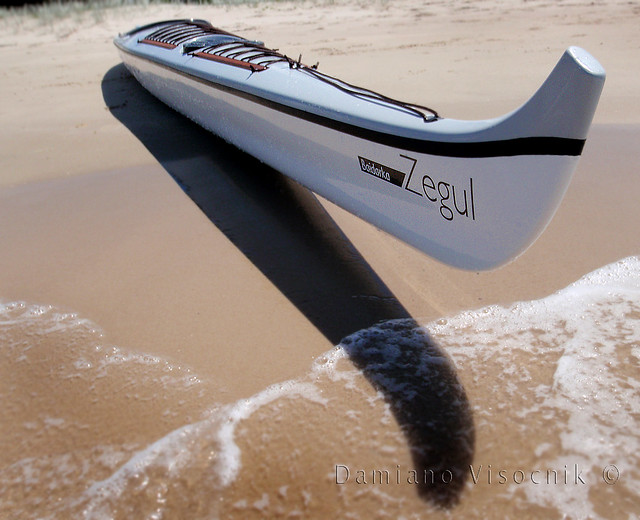
interesting bow, to say the least
The Baidarka has a unique way of lashing the generous deck bungee cords: a section of teak timber provides the anchor point. There is plenty of room to stash your gear on deck.
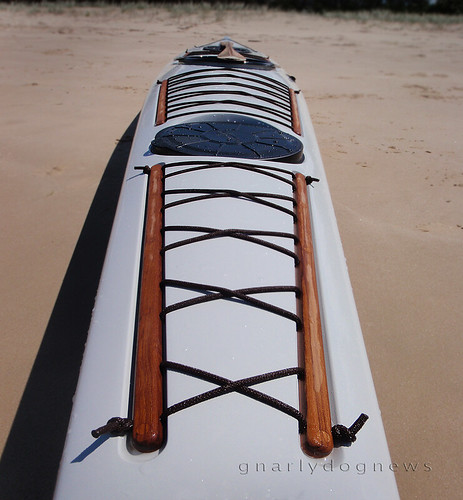
a fantastic finish of the deck's bungees
The Baidarka rolls easily thanks to the positive thigh braces however low laybacks are hindered by the rather high rear coaming.
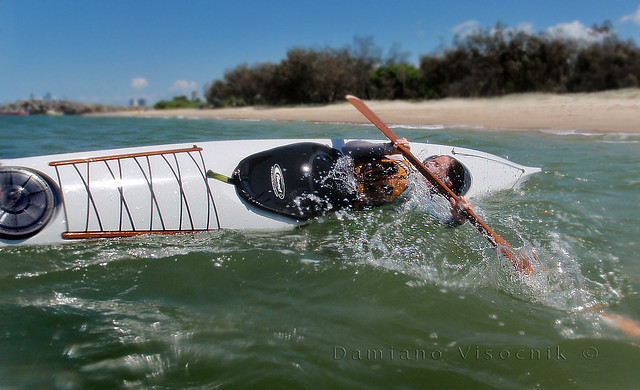
high brace with Aleut paddle.
The Reval is Tahe's other rudderless big-boat offering.
It has strong British style influence with a more chiseled deck look.
The cockpit has again plenty of room for large paddlers while still suited for lighter bodies. It is however not a low volume kayak. Maneuverability seemed very quick despite the size. I felt that the pronounced V shape of the keel line makes the kayak a bit tender on the primary stability. When sitting on the beach it leans to one side however the kayak felt solid when paddled. It tracked well for a rockered boat and was easily turned if edged. Weight didn't seem to slow down either kayak.
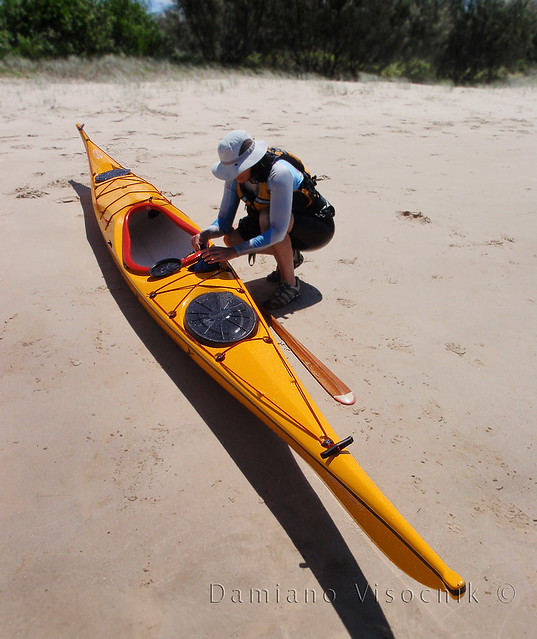
The deck has an indent for (surface) mounting a compass forward of the front hatch.
The bow and stern have a funny shape. Initially I thought it was rather bizarre but as soon as I grabbed the kayak to carry it to the beach I realized the reason for it: it sits very well in the hand and prevents slippage. A nice little touch. The seam tape on the Reval and Baidarka is 1/2" black aramide with no gelcoat cover. It looks very neat with a perfect finish.
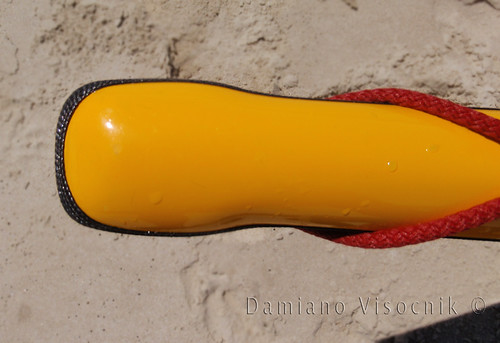
The skeg slider on the Tahes is superb: it slid smoothly and didn't seem to have any drag. A welcome discovery after seeing (and repairing) a few dodgy skegs on other branded kayaks.
Deploying the skeg made a strong effect on the kayak behavior and would correct the slight tendency to weathercock.
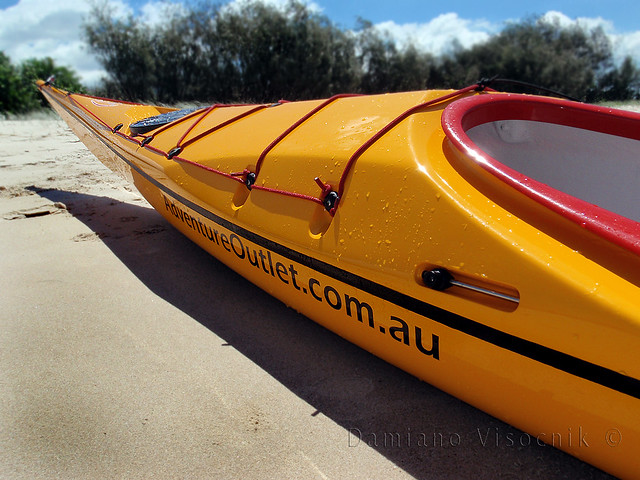
The cut-away on the deck next to the cockpit offers a paddle reach close to the hull for high angle paddling.
The cockpit has a positive space for my thighs (not just resting on little wings) and bracing in the Reval was great. The kayak rolled extremely easily for me and a fair degree of layback was possible.
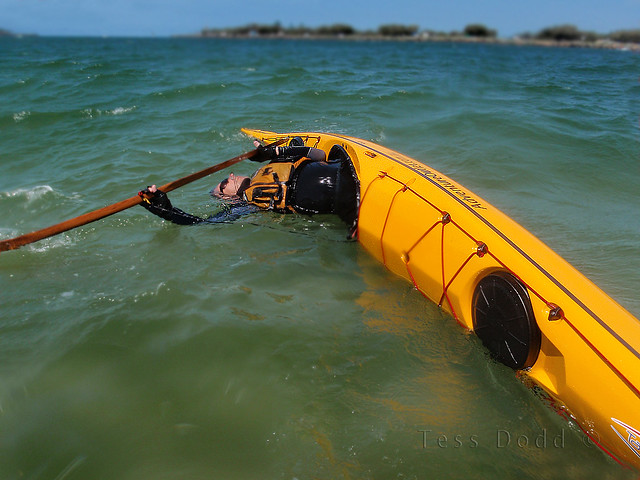
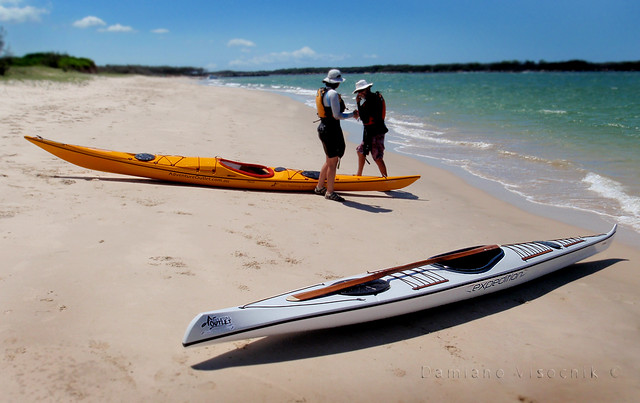
Test paddle conditions;
We loaded the kayaks with about 45 Kg alternatively. They were both paddled loaded and unloaded.
Test paddlers were of mid to heavy weight (68 to 110Kg) and mid to tall height (175 to 184cm)
There was an average of 8-10 knots of wind (gusting to 15kn) and there was 1-2 knots of tidal flow in some spots. The small wind waves were little indication on how the two boats would perform in following seas.
Only an extensive test paddle over several days would give us a better understanding on the kayaks' performance therefore any firm opinions on these kayaks ability are abstained.
This review's aim is to depict the two new kayaks since public images are very hard to come by.
Test kayaks were supplied by Adventure Outlet.


This post has generated a lot of interest.
ReplyDeleteThere have been comments on some international blogs that the review was commissioned and of professional nature.
Let me assure you that this is not the case.
I test and review products that interest me personally. I don't advertise for any manufacturer if I personally don't believe/use that item. I occasionally mention other products that I don't own but I have never been paid to do so.
This blog might appear of professional standard but that's because I try to deliver the best possible information and visual reference for the general public.
Gnarlydog News advertising policy can be viewed here:
http://gnarlydognews.blogspot.com/2010/05/gnarlydog-news-advertising-philosophy.html
thank you
ReplyDeleteI'm 6' 4" so my legs will not fit the footrests
when i lay my feet against the bulkhead i find it very comfortable
q: is the bulkhead strong enough to hold ?
will it break ?
should i add foam ?
thnx
Nissin, I am 6'1" (184cm) and the Baidarka that I test paddled had the bulkhead a long way away from my foot rest, there was plenty of adjustment left for a taller person. I was surprised that Tahe put the bulkhead there. If it was going to be my kayak I would have moved the bulkhead closer to my feet. You should be able to fit your feet on the footrest of the Baidarka unless not all of them I built like the one I tested.
ReplyDeleteto be accurate I'm considering of buying the reval
ReplyDeletethe question is how strong the bulkhead is
will it hold the pressure my feet will create
considering adding foam or minicell
my boat is chatham 17 which i realy love surfing with
i'm looking for a second kayak for long paddling
thnx
I am sorry but I didn't pay too much attention when I looked at the Reval's bulkhead. Unofrtunately I can't answer your question.
ReplyDeleteWARNING!
ReplyDeleteThe following comments are uncomplimentary of the Zegal "Baidarka" and may offend the thin-skinned paddlers out there in import-land.
The Zegal "Baidarka" is a post-modern pastiche of a true hunting kayak.
Its stylistic bow is all about appearance and nothing about performance.
The shape of an authentic Baidarka's bow was informed by the techniques of its construction and materiality - driftwood, bone and seal skin. Presumably the vacuum formed moulds at Zegul could not extend to the bifurcated bow so they just kept the bit that could be seen above the waterline.
This kayak design is a sham and a backwards step for an organisation that otherwise produces some excellent kayaks.
This kayak design is not unlike a faux-Federation house: built yesterday, pretending to be someting it is not and quite simply ridiculous.
An Inuit would burst out laughing at this toy and hoick a gob of bloody-whale infused spit upon it.
TEH, just as well that Zegul was not around when the Aleuts were kings of the sea or there could be some bad blood.
ReplyDeleteSeriously, I don't think Zegul claims to produce a replica of an original Baidarka (there are much truer interpretations in skin-on-frame replicas out there) but wants to bring to the masses a kayak that has some esthetical reminiscent of the original design. Apart from lacking the bifurcated bow the rest of the kayak seems to have big differences from the traditional crafts. The name Baidarka alone should not evoke a copy of those designs.
:)
ReplyDeleteOne last gripe about the bow on this boat and then I'll shut up ...
The bow ends clumsily and in an unresolved stub that presents an ugly focus to the kayak. No Aleut would be pleased with a bow like that. It looks as though it has been specifically designed to be ungraspable / unliftable.
It would have been a better kayak if they had not bothered with this stylistic bow detail.
Luke, we look forward to your haughty & entertaining comments on our boats - seems to strangely be always all about our boats - and the great knowledge you share with readers on designs that you have paddled extensively. Tell me how you felt the Baidarka handled when you paddled her? Does the unresolved stub actually have any design purpose? Does the crass phoney bifurcated bow perform in sea conditions? When did you paddle it again….?
ReplyDeleteTruly, the looks are just the wrapper, what matters is the way they perform.
Thanks so much for deigning us with your rare & poignant opinions.
Much love,
Mark (he of the thick skinned, greenland paddle planted firmly in cheek, paddler from import land).
Oh, oh, oh, I just can't stop laughing! This is such fun to read!
ReplyDeleteI just can't help jumping in here, as one of the few people who have extensively paddled (like for ten years ...) a modern interpretation of an Aleut hunter's kayak and carved Aleut paddle.
FIrst thing, have a look at the arctic kayaks web site by Harvey Golden and read Wolfgang Brink's book. Over the known evolution of Aleut kayaks, there have been so many different hull shapes, inspired by evolving Aleut naval architectural knowledge and changing hunting requirements, that there is no single authentic design. If you look hard enough, you can find several examples of the "unresolved stub" in museum examples, just as you can find upcurved lower jaws (full of phallic symbolism) like my baidarka, and even the weed-catching "Shields" and other 18th century designs.
My ten-year-old speedster is based almost exactly on the Berkeley Museum example from the early 20th century, so I can tell you many nice things about the stability and speed characteristics of that beautiful, skinny, highly swede-form, highly flared design.
It looks to me as if the Zegul Baidarka is heavily influenced by a Nick Schade design meant for wood-strip construction, which in turn is acknowledged to be based on the famous MAE-593-76, collected on Akun island in the Aleutian Islands in 1845 by the Russian explorer I. G. Vaznesenskii and housed in the Museum of Ethnology and Anthropology in St Petersberg.
As for the way an Aleut hunter would see this kayak: he'd be over the bloody moon about it! Don't think these guys were precious rather than practical about their craft. If it was fast, looked sleek and most importantly, brought the bacon home, then he'd have been all over it. Even after he broke it, he'd find a way to repair it and keep it going. Anything is better than sitting on shore all winter waiting for a driftwood log to wash up so he can start carving new 6 metre long gunwales and stringers with a bone scraper, to replace the last breadwinner's craft!
The authenticity that I can see in the Zegul Baidarka (in photos, so far, until I get to see it in the flesh) is in the strong impression it should give you of the very different hydrodynamics of an Aleut hunter's boat in a size that should fit a much larger Australian body. Do it; it will be an eye-opener! Wait 'til you have it in a following sea. Mine has been cranked up to over 28 km/h, with a touring load! Um, only once, but don't let that spoil the story.
The Baidarkonaut
Eyes and mind open, brain in gear, a little knowledge ... unending fun.
I don't know (or care much) about authenticity of the designs, but both of these kayaks look VERY interesting. I'm intrigued and would love to take them out for a paddle. I think it's great to see some variation in the form of the typical sea kayak.
ReplyDeleteCheers,
Bryan
I've posted a reaction to the Zegul "Baidarka" here: http://www.guillemot-kayaks.com/guillemot/blog/nick/how_should_i_react_zegultahe_baidarka
ReplyDeleteand linked back to this review.
I would appreciate your feedback.
I just wanted to point out that Nick Schade of Guillemot Kayaks has found some fairly egregious evidence that much of his design, and even worse, the text from his design description of the Aleutesque have been appropriated by Zegul without his permission. Not cool. More info is swirling on Qajaq USA.
ReplyDeleteNick, apologies for saying that there is no other kayak like that. Honestly I have never seen an Aleutesque and certainly never seen anything like the Zegul Baidarka in a composite boat. Needless to say that my knowledge of traditional design is limited.
ReplyDeleteReading your article it appears that Zegul did plagiarise parts of your design and text.
Not cool, actually bad.
Have you had the opportunity to paddle the Zegul Baidarka? I would be VERY interested to hear what do you think of her handling...
As noted in my comments ealier, the Zegul "Baidarka" would have been a better kayak if its manufacturers had not bothered with the stylistic and clumsy bow flourish.
ReplyDeleteBut as Nick Schade points out so diplomatically, he had already designed and built that kayak - the "Aleutesque".
I was right after all - The Zegal "Baidarka" is a post-modern pastiche.
A local shop is selling a Reval for a smokin price, and I'm looking for opinions on comparing it against a prijon kodiak, besides the obvious construction materials differences, etc. I'm 6'4" and 260 lbs with intermediate experience.
ReplyDeleteMany thanks for any input!
Donovan
Donovan,
ReplyDeleteI am 6'1" and 240lbs. I found the Reval suited for my weight and size (enough room under the deck for my thighs). The kayak is not ideal for a beginner but works for intermediate and beyond.
If it is a smoking deal then it's a no brainer; it's Xmas after all and you know you have been good this year :-)
Thanks so much for the speedy reply! I've heard that Tahe boats are built with speed taking precedence over stability, is that a fair assertion? Also, how about durability? I'd be paddling in puget sound, not typically known for soft, sandy beaches.
ReplyDeleteDonovan, I only had a brief paddle in the Reval but my inspection revealed a decent lay-up with no visible faults. I won't say that is a sturdy as the Zegul range (vacuum infused epoxy foam cored carbon/Kevlar) or premium British boats but the Reval seemed a good compromise of lightweight and sturdiness for non abusive sea kayaking (I would avoid seal launches from rocks, but that's in any kayak). Initially stability with my weight (no cargo) was fair (not as stable as some other kayaks of mine) but the secondary was reasonable. Of Course this statement is very hard to quantify for me since is subjective my skills (or lack of).
ReplyDeleteUnless you plan some hard landings with speed I believe the Reval works fine.
Greetings...
ReplyDeleteYears and years later, but actually snagged an all-black Zegul Baidarka online today. (for a pittance) I plan on loading it up for some week-long "expeditions" off Victoria BC due to my "retired" status.
I already have a play boat - this boat was chosen for it's carrying capacity and cruising efficiency and after seeing videos of an almost non-existent boat wake I was sold.
Cheers, Damion!
Scott